AAC in Secondary School: Using Surveys to Support Language Learning
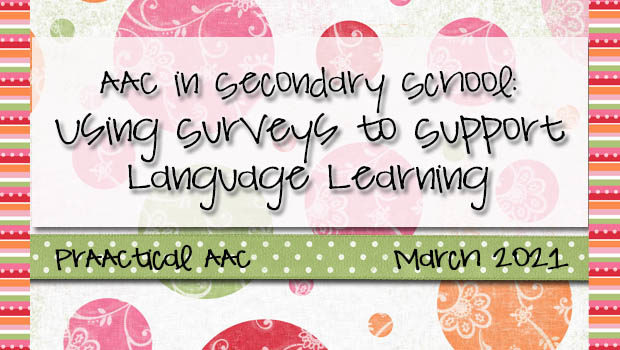
 It’s a great day to explore ways to support AAC use, and today AAC SLP Ashley Larisey joins us with some activity suggestions and lots of implementation tips. Ashley is an SLP at Community High School District 218 in Oak Lawn, Illinois. She is also an Adjunct Clinical Supervisor and Instructor at Saint Xavier University.
It’s a great day to explore ways to support AAC use, and today AAC SLP Ashley Larisey joins us with some activity suggestions and lots of implementation tips. Ashley is an SLP at Community High School District 218 in Oak Lawn, Illinois. She is also an Adjunct Clinical Supervisor and Instructor at Saint Xavier University.
This post, part of the AAC in Secondary School series, focuses on the use of language experience surveys with students who are learning to use AAC.
::::::::::::::::::::::::::::::::::::::::::::::::::::::::::::::::::::::::::::::::::::::
Surveys
Surveys can be used within almost any classroom activity to provide students with opportunities to communicate with both familiar and non-familiar listeners. Questions that are used for the survey can be used to gather more information about a topic that guides decision-making. Surveys can be embedded into academic, social, vocational, and community-based instruction. Take a look at some examples of how to use surveys in your classroom for your AAC user(s):
- Formulate the Question – The first step in composing a survey is to formulate the question. What do we want to know, and what information will a survey provide to us that will guide our decision-making? Surveys can be done strictly for fun, but I also enjoy coming up with purposeful questions that guide instruction. This can help make surveys more meaningful. If one answer comes out above the rest, what does that mean? What will change or happen based on the results? For example:
- Which graphic novel should we read next?
- This is an academic-focused question that will provide some student ownership in selecting what they would like to learn or read about.
- What new item should we sell at the snack cart?
- Questions like these can be used to gather more information about how an existing job can be improved for the better. These questions can be formulated for a wide variety of vocational skills.
- Which Chicago restaurant has the best pizza?
- This is an example of a “just for fun” question, but it could be embedded into a community trip that focuses on a central topic. Another example of this would be to create a survey asking about a favorite exhibit at a museum. The response that is most popular could be planned as the first exhibit visited on the trip.
- Which graphic novel should we read next?
Suggestions for implementation:
- Introduce your topic (e.g. snack cart foods). Provide aided language stimulation while highlighting some of the different question words that could be used to gather more information (e.g. WHO should we ASK about the snack cart, WHAT do you wish you could BUY?). Aided language is most beneficial when provided at 1-2 units beyond what an individual is communicating.
- Brainstorm some of the possible responses to the question together. If we are talking about snack foods that we could add to the cart, let’s look at some of the SNACKS people might want to EAT. Pick a few choices to add to your survey as possible responses. I always like to leave a spot for “something different” in the event that a communication partner provides a different response. Provide opportunities to embed student-specific interests to increase motivation and generate buy-in for the activity. “WHAT are some of the snacks that YOU would like to EAT?” Make sure to add at least one of the student-specific choices to your survey.
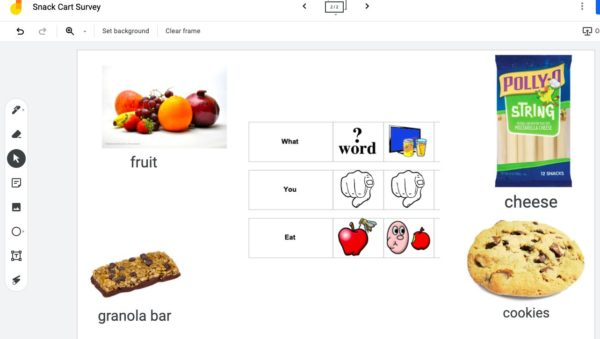
Generating choices (Jamboard/AAC Language Lab Smart Chart Generator)
- Model making mistakes! This can be used to bring attention to examples vs. non-examples (Frayer model). Example: “I think we should add Target to our survey. Wait – NO! Target is a place we GO, not something we EAT!
- Work through each of the generated choices. Which ones do your students LIKE or NOT LIKE?
- Create the survey – Next, create the survey together. Decide on the way that survey data will be collected. Whether you are composing the survey as a group or individually, the method of collection can be easily differentiated to address different goals. Some examples include:
- Paper-based: There are some excellent survey templates available on LessonPix (e.g. Tally Cards) that can be used to create paper-based surveys. This is a good symbol-based option to support communication and interaction.
- Google Forms: This is another great tool to use to create the survey. Students can generate a survey title, document the survey question, and enter the possible responses using a multiple-choice format.
Suggestions for Implementation:
- Talk about WHO the target audience (a great word to describe using descriptive teaching) is for this survey. If you are asking questions about the snack cart at school, you wouldn’t want to send the survey to your distant relatives who live out of state. Who does the survey impact? This can be a great time to involve some favorite communication partners around the school, or it can also be an opportunity to ask/meet someone new!
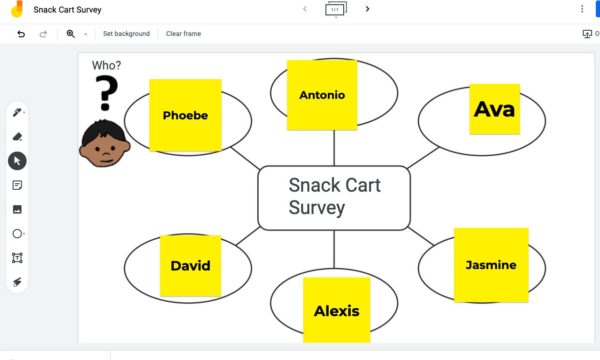
Brainstorming WHO: Jamboard/LessonPix
- Involve your students in the creation of the survey as much as possible. It is important that they have ownership and investment in the creation of the survey. For emergent communicators, I love providing choices for the survey design. Giving choices regarding the symbols they want to use and other design aspects like font, color, and graphics can go a long way towards increasing ownership. This goes for paper-based collection as well as google forms.
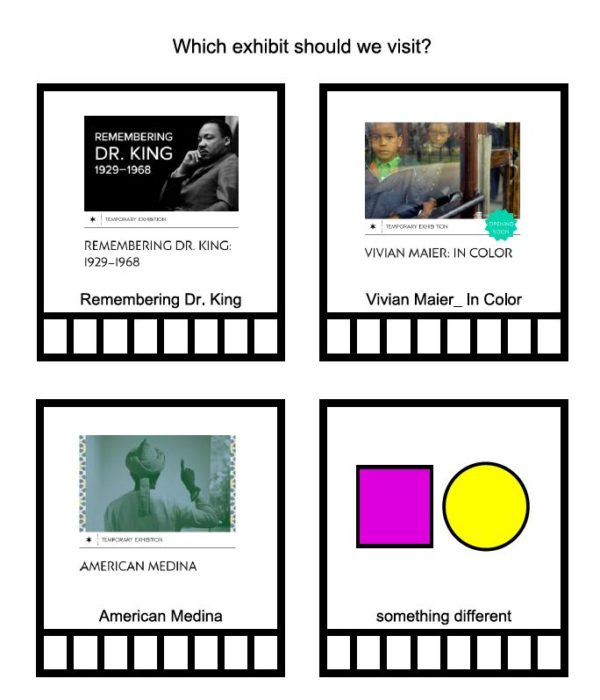
LessonPix survey (Tally Cards)
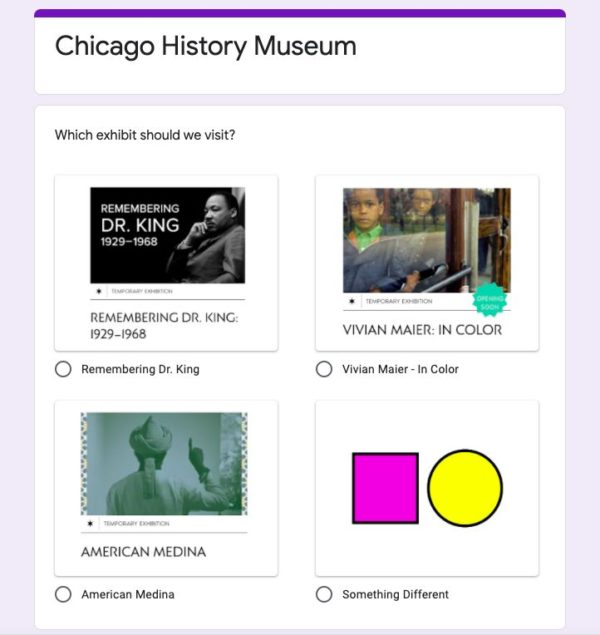
Google Forms Survey
- Conduct the Survey – This is where the excitement happens! Students can either go out and about around the building to ask their survey question to various people in the target audience (identified in Step 1), or your students can use other options, like e-mail, phone calls, or Facetime/Zoom.
- In-person questions: Students can practice skills like greeting, asking the target question, making comments, and closings for each exchange. Some students may be working on generating these messages independently or using visual supports or other prompts. Others may work with their teacher, paraprofessional, or another team member on creating a co-planned sequenced social script (Musselwhite/Burkhart) to engage in the exchange. This can be particularly useful for students who are using switches or are still learning the linguistic and social competencies required to engage in multiple conversational exchanges.
Students can use a variety of different tools to record the responses of conversational partners. Some different options are highlighted below:
- Phone Calls/FaceTime/Zoom: Surveys can provide great opportunities to practice brief exchanges using these different modalities. This can be particularly useful when surveying individuals who are not within the immediate environment. It also provides an opportunity for AAC to place phone calls or use Facetime with trusted communication partners. It is important to note that phone calls can be intimidating for many individuals, and some AAC users report barriers in using the phone. As always, valuing the preferences of the individual and remaining person-centered is important. Some individuals love using Zoom or Facetime; others prefer e-mail. If a student does choose to explore phone calls and Facetime, beginning with conversational partners who are familiar to the student can provide great opportunities to practice using introductory strategies and troubleshooting any strategic issues that may arise (e.g. volume too low) during a call. Take the students’ lead!
- E-mail: If students have elected to create a google form, one of the best ways to send this out is via e-mail. This provides context to teach the foundational concepts of sending an e-mail without time pressure. Students can work on the various different components of e-mail (To, Subject, Greeting, Content, Closing, Signature). The content of the e-mail will provide many opportunities for embedded communication
Suggestions for Implementation:
- Review individual responses after they were collected. This can provide a great framework for practicing generating subject+verb+object sentences:
- Emmanuel wants coffee.
- Susie likes pepperoni pizza.
- David wants granola bars.
- Provided aided language to encourage comments about responses. Statements like “Me too!” “No way!” or “Are you serious?” are non-obligatory turns that keep the conversation moving.
- Embedding WHO and WHERE is easily integrated into surveys. WHO should we ask next? WHERE are they (classroom, gym, lunch) right now? This can be useful when working with students who are still learning how to differentiate wh-question types.
- Organize the data and sharing results – data collection and organization is easily integrated with lots of math concepts. If students are using Google Forms, the responses can be viewed using a bar graph or pie chart.
Suggestions for Implementation:
- Providing visual examples of concepts like MORE, LESS, MOST, and LEAST can be used to talk about the results. Results can also be organized into a pie chart to talk about concepts like HALF, QUARTER, etc.
- Graphing can be done individually or as a classroom group. Results can be graphed using anything from paper and pencil to other software programs.
- Have your students share the results! Individuals who are completing the survey love to hear which option won. This can be done over announcements (ask your students WHO would like to make the announcement), e-mail, or visual display.
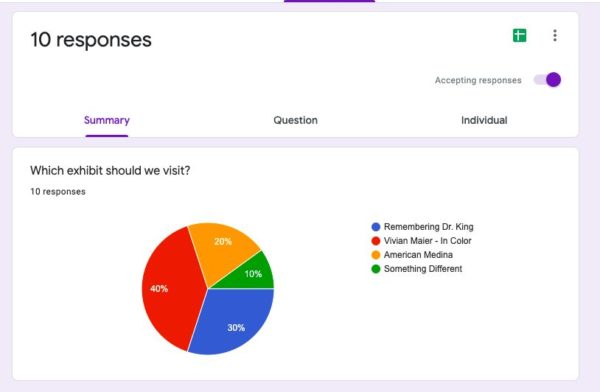
Survey Results
Have you used surveys in your instruction? I’d love to hear your ideas!
Resources
- LessonPix. Retrieved from: www.lessonpix.com
- AAC Language Lab: Retrieved from: www.aaclanguagelab.com
- Musselwhite C & Burkhart L. (2001). Can We Chat? Co-Planned Sequenced Social Scripts. Special Communications and Linda Burkhart.
- Van Tatenhove. G. (2009). Building Language Competence with Students Using AAC Devices: Six Challenges. Perspectives on Augmentative and Alternative Communication, 18(2), 38-47.
::::::::::::::::::::::::::::::::::::::::::::::::::::::::::::::::::::::::::::::::::::::::::::::
Here are some previous posts in the series.
Filed under: Featured Posts, PrAACtical Thinking
Tagged With: education, high school, teens
This post was written by Carole Zangari

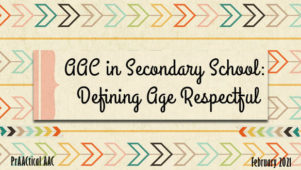

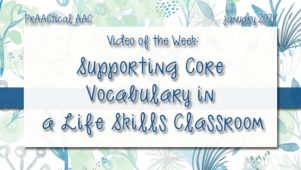
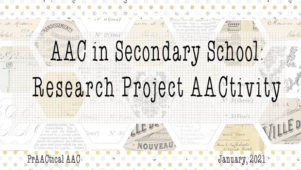
1 Comment
I think this is such a wonderful way to identify and provide access to the vocabulary that people will need to communicate their personal interests and preferences, and to be able to interact with others. Wonderful post!